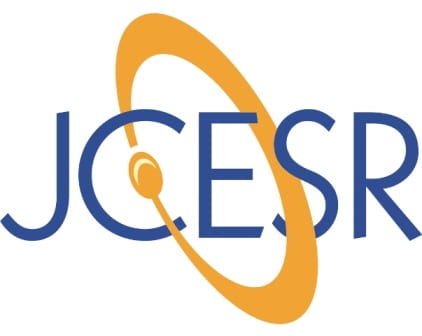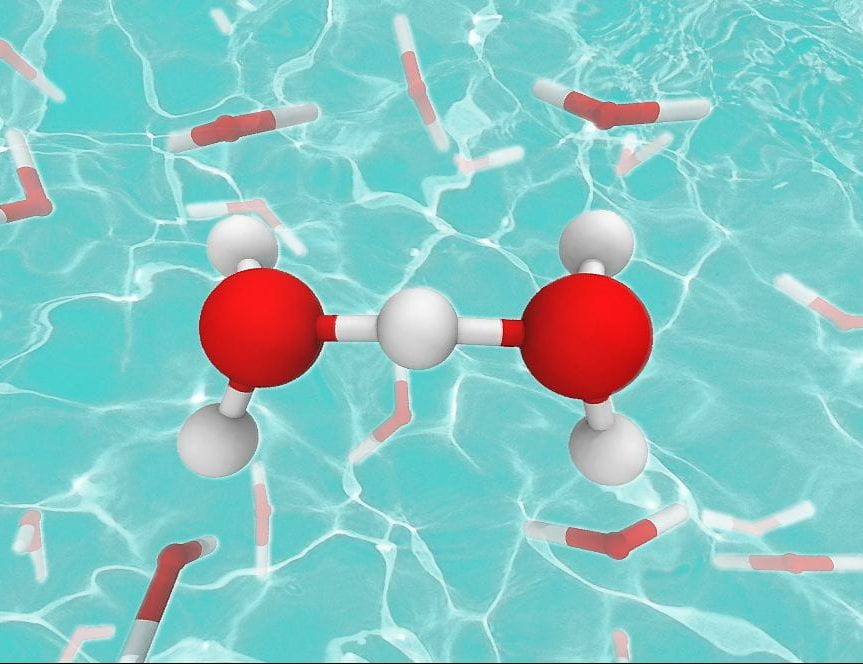Our Research
Dynamics of Water and Electrolytes
Dynamics of Biomolecular Association
Fluorescence-Encoded Infrared Spectroscopy
Spectroscopy and Instrumentation
The Tokmakoff Group investigates the dynamics of water, aqueous solutions, and biological macromolecules during the course of chemical reactions and biophysical processes.
Overview
Our research projects include the molecular mechanism of aqueous proton transport, the structural dynamics of electrolyte solutions, and the mechanism of molecular recognition and binding that underlie protein-protein interactions or DNA hybridization. These studies are supported by grants from the DOE, NSF, and NIH.
Our studies are enabled by the new experimental tools that we develop to visualize molecular motion as it occurs in these processes. These are time-resolved vibrational spectroscopies—such as 2D IR spectroscopy—that track changes to structure-sensitive bond vibrations, together with computational spectroscopy based on molecular dynamics simulations that translate time-dependent molecular structures into the spectra we measure.
Dynamics of Water and Electrolytes
Despite its importance throughout chemistry and biology, many molecular details about liquid water and its interactions with aqueous solutes remain elusive. Water’s properties emerge from a complex interplay of interactions at a molecular level, including its hydrogen-bonding network, which fluctuates and rearranges on femtosecond-to-picosecond timescales, and the collective electrostatics of molecules within the network.
Our current efforts focus on understanding the fundamental aspects of electrolyte solutions that play an important role in redox chemistry, acid-base chemistry, solvation, and ion transport. We use ultrafast 2D IR and transient absorption spectroscopy to study how water’s unique hydrogen-bonding, collective electrostatics, and rapid configurational dynamics influence the properties of aqueous solutes. Our recent studies of the aqueous proton indicate the dominant structure is a complex with a proton strongly bound between two water molecules and that protons migrate by a concerted shifting of protons along the hydrogen bond network on a picosecond timescale. We are studying concentrated electrolyte solutions to reveal ion pairing and clustering, characterize ion solvation, and investigate other dynamical structures involving co-ions and counter-ions, such as the highly interconnected ion-rich network in concentrated lithium bistriflimide solutions.
Dynamics of Water and Electrolytes
Despite its importance throughout chemistry and biology, many molecular details about liquid water and its interactions with aqueous solutes remain elusive. Water’s properties emerge from a complex interplay of interactions at a molecular level, including its hydrogen-bonding network, which fluctuates and rearranges on femtosecond-to-picosecond timescales, and the collective electrostatics of molecules within the network.
Our current efforts focus on understanding the fundamental aspects of electrolyte solutions that play an important role in redox chemistry, acid-base chemistry, solvation, and ion transport. We use ultrafast 2D IR and transient absorption spectroscopy to study how water’s unique hydrogen-bonding, collective electrostatics, and rapid configurational dynamics influence the properties of aqueous solutes. Our recent studies of the aqueous proton indicate the dominant structure is a complex with a proton strongly bound between two water molecules and that protons migrate by a concerted shifting of protons along the hydrogen bond network on a picosecond timescale. We are studying concentrated electrolyte solutions to reveal ion pairing and clustering, characterize ion solvation, and investigate other dynamical structures involving co-ions and counter-ions, such as the highly interconnected ion-rich network in concentrated lithium bistriflimide solutions.
Dynamics of Biomolecular Association
Biological macromolecules, such as proteins and nucleic acids, have the fascinating ability to spontaneously self-assemble into well-defined structures. We study the mechanism of these bimolecular processes, including protein-protein interactions and DNA hybridization, in which two binding partners diffusively encounter one another, and then recognize and bind each other with site-specific contacts. Our strategy uses a laser-induced temperature-jump to thermally dissociate a bound protein complex or DNA duplex, and uses 2D IR to track time-resolved conformational changes on nanosecond to millisecond time scales. We collaborate with theory groups that simulate these challenging problems and use structural modeling of IR spectra to interpret the dynamical processes present in our experiments.
Our current investigations of protein recognition and binding focus on the association of two insulin molecules to form a dimer. Temperature-jump experiments reveal complex configurational changes to the helices and β sheet within the dimer spanning nanosecond to millisecond timescales prior to dissociation. We are investigating these processes in detail by incorporating site-specific isotope labels to look for changes to specific contacts, and are working with the Markov State models and advanced sampling molecular dynamics employed by our collaborators to reveal the dissociation and association mechanisms.
DNA oligonucleotides exhibit structural dynamics ranging from base-pairing fluctuations occurring in tens of nanoseconds to association of duplex and more complicated structures over hundreds of microseconds to milliseconds. The thermodynamics of DNA melting and hybridization has been investigated for decades, yet most aspects of the complex dynamics of these processes remain poorly understood. We directly probe the melting dynamics of DNA over many decades in time with base-specific sensitivity and investigate how sequence, strand length, and nucleobase chemical modification and protonation alter DNA duplex dehybridization dynamics.
Fluorescence-Encoded Infrared Spectroscopy
IR spectroscopy is an insensitive method due to low absorption cross-sections, poor mid-IR detectors, and a lack of luminescence. We have recently introduced fluorescence-encoded IR (FEIR) spectroscopy, which enhances sensitivity by orders of magnitude by encoding an IR vibrational excitation into a visible fluorescence signal. Using confocal microscopy, high repetition-rate excitation, and single-photon counting we have pushed the sensitivity of FEIR to the single-molecule regime. We are developing fluctuation-correlation and single-molecule FEIR experiments that use vibrations to monitor the spontaneous changes in chemical structure characteristic of exchanging systems at equilibrium.
Fluorescence-Encoded Infrared Spectroscopy
IR spectroscopy is an insensitive method due to low absorption cross-sections, poor mid-IR detectors, and a lack of luminescence. We have recently introduced fluorescence-encoded IR (FEIR) spectroscopy, which enhances sensitivity by orders of magnitude by encoding an IR vibrational excitation into a visible fluorescence signal. Using confocal microscopy, high repetition-rate excitation, and single-photon counting we have pushed the sensitivity of FEIR to the single-molecule regime. We are developing fluctuation-correlation and single-molecule FEIR experiments that use vibrations to monitor the spontaneous changes in chemical structure characteristic of exchanging systems at equilibrium.
Spectroscopy and Instrumentation
Our studies are made possible by the continuous development of new methods and instrumentation to increase our ability to reveal molecular dynamics. Since we probe molecular structures with ultrafast IR spectroscopy, our investigations rely on advancing ultrafast IR optics and spectroscopy, including new femtosecond infrared laser sources, ultrafast time-resolved spectroscopies, and novel IR detection schemes. We have developed new ways of generating and amplifying broadband femtosecond pulses that span the entire fingerprint region of the mid-infrared spectrum, and recently designed a unique 1 MHz femtosecond mid-IR optical parametric amplifier that enables FEIR.
We use transient temperature-jump 2D IR to track relaxation dynamics occurring between 10 ns and 1 ms, and have applied this to study protein unfolding, protein-protein dissociation, lipid phase transitions, nucleobase tautomerism, and DNA dehybridization. A recently developed cw temperature-jump 2D IR spectrometer extended our capabilities to <1 millisecond to second kinetics.
For our studies of bimolecular association reactions and other chemical kinetics and dynamics, we are developing mid-IR compatible microfluidic mixing techniques to probe dimer association with <50 microsecond time resolution and inducing new types of abrupt chemical perturbations (pH, salt, concentration, etc.).










